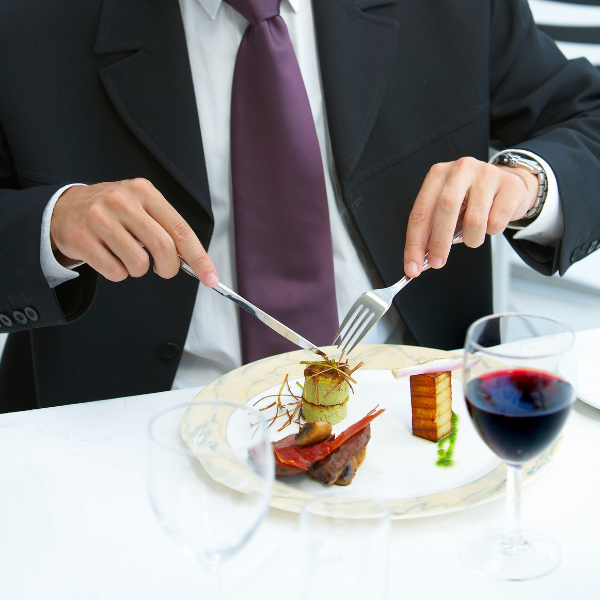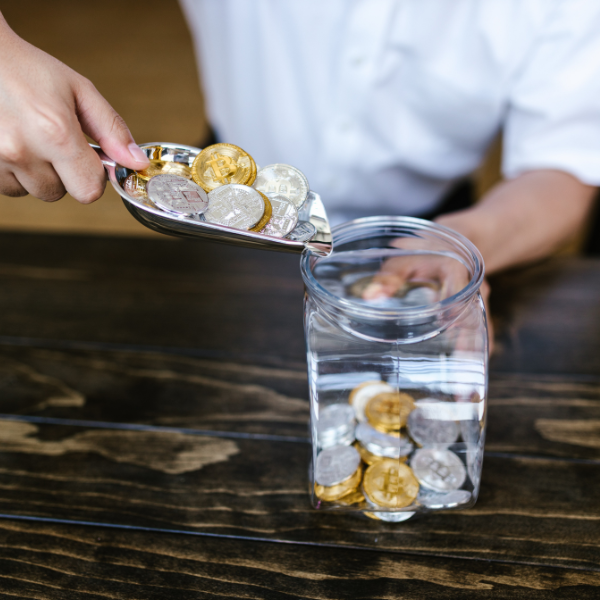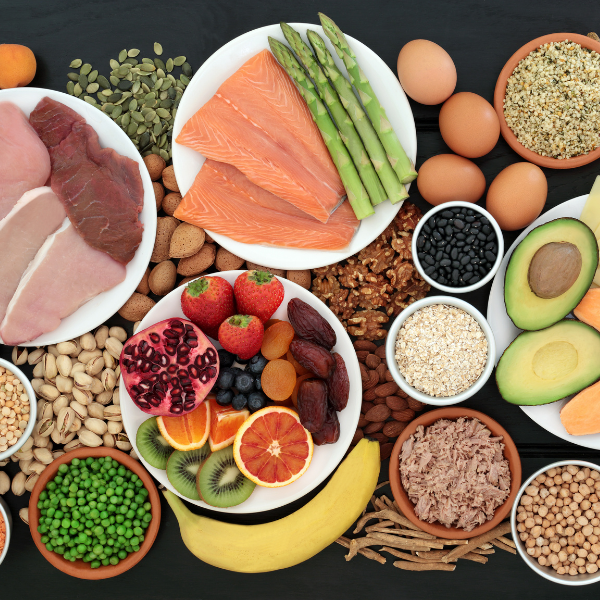If someone were to order a Moscow Mule, you likely wouldn’t serve it to them in the same glass you would serve a martini. Specific cocktails typically have corresponding glasses that they are served in. But, how can you know which glass to use with such a wide variety of glass types? In this guide, we break down everything you need to know about cocktail glasses, including why the difference matters, the defining features of cocktail glasses, and the specific types used for each drink.
Differences In Cocktail Glasses
We know that there’s a difference in cocktail glasses, but what exactly makes them different? There are features of each specific kind of glass that sets it apart. Below we’ve compiled the general characteristics that make each cocktail glass unique from one another.
Shape
The shape of cocktail glasses is one of the most noticeable features. You want the drink presentation to catch your customers’ attention, beginning with the glass. Cocktails are usually visually appealing, whether a fun mixed drink with a unique color or a simple whiskey with a classic pour. In any case, how the drink looks determine the feel of the drink, and the glass itself plays a role in that.
The shape also affects the aromatics and flavors of the liquor. Some glasses require a specific shape to enhance or maintain the flavors. The shape not only benefits the person enjoying their beverage, but it also makes a difference to the mixologist. V-shaped glasses — such as martini or margarita glasses — help keep the ingredients mixed properly. Glasses with a tall, cylindrical shape — like highball or Collins glasses — allow ample space for mixers, ice, and stirring.
Size
The size of a cocktail glass matters for providing the right amount of a beverage to the customer. For example, mixed cocktails carry more volume than a shot, requiring larger glasses. The type of glass can influence the speed at which the person enjoys their drink. Some glasses are easier to handle, so it may lead the customer to drink their cocktail faster. Each drink has specific measurements. For example, mixed drinks require the right liquor to mixer ratio. When these measurements are so specific, it affects the size of the glass they are served in.
Material
Although they’re referred to as cocktail glasses, not all cups are made of glass. Other materials can be used to make cups for cocktails. Some cocktail glass materials include:
- Copper: Copper or tin are used for chilled drinks such as Moscow Mules or mint juleps. These types of drinks require proper insulation to maintain their flavor.
- Plastic: Plastic drinkware can be available for cocktails as a more cost-effective option. Some establishments also opt for plastic glasses for more casual, outdoor settings.
- Glass: Glass is the most common material used for cocktail cups. It’s elegant and allows patrons to see their drink inside of the glass, which is visually appealing.
Types Of Cocktail Glasses
There is a wide variety of cocktail glasses. Each one is uniquely suited to best fit the beverage it holds, bringing out the aromas and flavors of the drink. Ranging in capacity, size, and design, below is a comprehensive list of the different types of cocktail glasses.
Highball Glasses
Highball glasses are very versatile. They can be used for a variety of cocktails, usually mixed drinks. They’re tall and cylindrical, offering ample space to pour mixed beverages into the cup, usually over ice.
Highball Glass Capacity:
- 8 to 12 ounces
Best Used For:
- Bloody Mary
- Long Island Iced Tea
- Rum and Coke
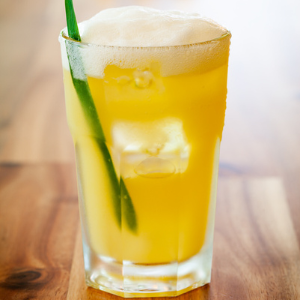
Collins Glasses
Collins glasses are very similar to highball glasses. The difference between the two is very minimal. Collins glasses are slightly taller and can contain a couple more ounces than a highball glass. What makes a Collins glass a staple is that in addition to cocktails, it is also used to serve non-alcoholic drinks such as soft drinks, juices, or mocktails.
Collins Glass Capacity:
- 10 to 14 ounces
Best Used For:
- Tom Collins
- Mojito
- Singapore Sling
Lowball Glasses
Also called an old-fashioned glass or a rocks glass, a lowball glass is similar in shape to a highball glass, but much shorter. It’s typically used to serve spirits like whiskey and offer a wide base that’s suitable for muddling ingredients such as mint. A double lowball glass, despite its name, does not have double the capacity but can only hold about two more ounces than a single.
Lowball Glass Capacity:
- Single: 6 to 10 ounces
- Double: 12 to 16 ounces
Best Used For:
- Old Fashioned
- White Russian
- Scotch (neat or on the rocks)
Martini Glasses
A martini glass is one of the most recognizable cocktail glasses out there. It features a long stem with a v-shaped bowl. This shape helps control the temperature as well as the wide mouth, enhancing the aromas of the beverage. This glass can be used for martinis served shaken or stirred, as well as other cocktails.
Martini Glass Capacity:
- Standard: 6 to 8 ounces
- Large: Up to 12 ounces
Best Used For:
- Martini
- Cosmopolitan
- Manhattan
Copper Mugs
Most often associated with Moscow Mules, copper mugs are a unique option when it comes to serving cocktails. Because they are not made of glass — similar to many of the other types of glasses — they offer different features. These mugs have a handle that minimizes heat transfer to the drink. Additionally, these cups are great for insulating cold drinks, keeping them chilled while guests sip.
Copper Mug Capacity:
- 16 to 20 ounces
Best Used For:
- Moscow Mule
- Mint Julep
- Greyhound
Margarita Glasses
Margarita glasses are typically used for serving cocktails, but can also be used to serve finger foods such as shrimp cocktails or fruit. They have a unique shape: a welled bowl that is narrow near the stem and wide around the rim. The rim of these glasses is often garnished with salt, but sometimes features sugar, spices, or crushed candies
Margarita Glass Capacity:
- Can vary in size from 6 to 20 ounces
Best Used For:
- Margarita
- Frozen Margarita
Nick And Nora Glasses
Similar to the name, Nick and Nora glasses are very unique. Drinks served in these glasses are usually shaken or stirred — similar to those served in a martini glass — and should not be served with ice. Chilling these glasses before use is recommended to maintain the drink's temperature. This glass has a bell shape, resembling a wine glass but smaller.
Nick and Nora Glass Capacity:
- 6 to 7 ounces
Best Used For:
- Bamboo
- Lion’s Tale
- Alaska Sour
Coupe Glasses
Coupe glasses have a stem, a shallow bowl and a wide, round mouth. The stem keeps the drink from getting warm while holding the glass. Similar to beverages served in Nick and Nora glasses, cocktails served in a coupe glass are often served "up," meaning without ice.
Coupe Glass Capacity:
- 6 to 8 ounces
Best Used For:
- Sidecar
- Martinez
- Gimlet
Shot Glasses
A shot glass is easily identifiable as it is the smallest cocktail glass. Shot glasses are short and narrow. They are used for straight shots or shooter cocktails, which are small cocktails that contain alcohol and a mixer. There are different shapes of shot glasses; some are narrow and tall and usually used for layered shots, while others are shorter and wider, used for more straight liquor shots.
Shot Glass Capacity:
- Single: 1.5 ounces
- Double: 2 to 3 ounces
Best Used For:
- Kamikaze shot
- Pineapple Upside Down Cake shot
- Tequila shot
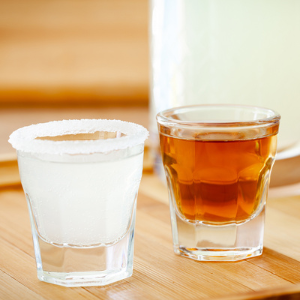
Snifter Glasses
Snifter glasses can also be called brandy snifters or brandy glasses. They are short stemmed glasses with a wide bottom and a narrow top. This shape makes it easier to hold the cup in the palm of the hand, encouraging heat transfer, which is typical for drinks served in this glass.
Snifter Glass Capacity:
- 6 to 8 ounces (but are normally only filled to a small portion of that)
Best Used For:
- Brandy
- Whiskey
- Stout beer
- Cognac
Cordial Glasses
Because of their size and capacity, cordial glasses are similar to shot glasses. However, cordial glasses have a stem and are meant for sweet liqueur or cordials, such as an after-dinner liqueur. Drinks served in these glasses are meant to be sipped, rather than drank all in one like a shot. They're also great for layered concoctions that are intended to be enjoyed in a specific order.
Cordial Glass Capacity:
- 1.5 to 2 ounces
Best Used For:
- After-dinner liqueurs
- Dessert wines
- Layered drinks
Hurricane Glasses
Hurricane glasses have a distinctive shape that makes them stand out from the other cocktail glasses. They are tall and curvy with a short stem. They’re on the side of the larger size glasses, providing plenty of space for larger-sized drinks.
Hurricane Glass Capacity:
- 15 to 20 ounces
Best Used For:
- Hurricane
- Daiquiri
- Pina Colada
Gin Glasses
These glasses have a balloon-shaped bowl with a stem. This shape helps bring out the aromas of the gin while the stem avoids heat transfer. Because of their size, it allows for ice to be added to the drink without taking up too much space.
Gin Glass Capacity:
- 10 to 20 ounces
Best Used For:
- Gin and Tonic
- Gin and Cucumber
- Gin neat
Do I Need All Of These Glasses?
If your establishment is looking to have an extensive list of cocktails available and you want a uniquely tailored experience, you can buy each type of glass. But, the number of different kinds of cocktail glasses can be overwhelming. Because so many of them have only slight differences in shape or size, you can get by having a few staples and using them for different types of cocktails. For example, coupes, Nick and Noras, and martini glasses are all very similar. If you choose to only get one of those glasses, it can help you save money and still accomplish the effect you want specific drinks to have.
Bottoms Up!
With so many different cocktail glasses to choose from, it can get confusing. Knowing the difference between cocktail glasses can help you make the best-informed decision for your establishment. Whether you want one type of glass for every drink or a few staples to rotate between, this guide provides you with the information needed to choose glasses that your guests will love.


